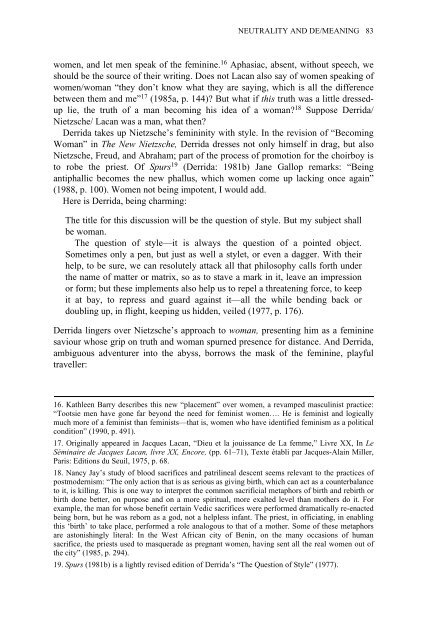Nothing Mat(t)ers: A Feminist Critique of Postmodernism
Nothing Mat(t)ers: A Feminist Critique of Postmodernism
Nothing Mat(t)ers: A Feminist Critique of Postmodernism
Create successful ePaper yourself
Turn your PDF publications into a flip-book with our unique Google optimized e-Paper software.
NEUTRALITY AND DE/MEANING 83<br />
women, and let men speak <strong>of</strong> the feminine. 16 Aphasiac, absent, without speech, we<br />
should be the source <strong>of</strong> their writing. Does not Lacan also say <strong>of</strong> women speaking <strong>of</strong><br />
women/woman “they don’t know what they are saying, which is all the difference<br />
between them and me” 17 (1985a, p. 144) But what if this truth was a little dressedup<br />
lie, the truth <strong>of</strong> a man becoming his idea <strong>of</strong> a woman 18 Suppose Derrida/<br />
Nietzsche/ Lacan was a man, what then<br />
Derrida takes up Nietzsche’s femininity with style. In the revision <strong>of</strong> “Becoming<br />
Woman” in The New Nietzsche, Derrida dresses not only himself in drag, but also<br />
Nietzsche, Freud, and Abraham; part <strong>of</strong> the process <strong>of</strong> promotion for the choirboy is<br />
to robe the priest. Of Spurs 19 (Derrida: 1981b) Jane Gallop remarks: “Being<br />
antiphallic becomes the new phallus, which women come up lacking once again”<br />
(1988, p. 100). Women not being impotent, I would add.<br />
Here is Derrida, being charming:<br />
The title for this discussion will be the question <strong>of</strong> style. But my subject shall<br />
be woman.<br />
The question <strong>of</strong> style—it is always the question <strong>of</strong> a pointed object.<br />
Sometimes only a pen, but just as well a stylet, or even a dagger. With their<br />
help, to be sure, we can resolutely attack all that philosophy calls forth under<br />
the name <strong>of</strong> matter or matrix, so as to stave a mark in it, leave an impression<br />
or form; but these implements also help us to repel a threatening force, to keep<br />
it at bay, to repress and guard against it—all the while bending back or<br />
doubling up, in flight, keeping us hidden, veiled (1977, p. 176).<br />
Derrida ling<strong>ers</strong> over Nietzsche’s approach to woman, presenting him as a feminine<br />
saviour whose grip on truth and woman spurned presence for distance. And Derrida,<br />
ambiguous adventurer into the abyss, borrows the mask <strong>of</strong> the feminine, playful<br />
traveller:<br />
16. Kathleen Barry describes this new “placement” over women, a revamped masculinist practice:<br />
“Tootsie men have gone far beyond the need for feminist women…. He is feminist and logically<br />
much more <strong>of</strong> a feminist than feminists—that is, women who have identified feminism as a political<br />
condition” (1990, p. 491).<br />
17. Originally appeared in Jacques Lacan, “Dieu et la jouissance de La femme,” Livre XX, In Le<br />
Séminaire de Jacques Lacan, livre XX, Encore, (pp. 61–71), Texte établi par Jacques-Alain Miller,<br />
Paris: Editions du Seuil, 1975, p. 68.<br />
18. Nancy Jay’s study <strong>of</strong> blood sacrifices and patrilineal descent seems relevant to the practices <strong>of</strong><br />
postmodernism: “The only action that is as serious as giving birth, which can act as a counterbalance<br />
to it, is killing. This is one way to interpret the common sacrificial metaphors <strong>of</strong> birth and rebirth or<br />
birth done better, on purpose and on a more spiritual, more exalted level than moth<strong>ers</strong> do it. For<br />
example, the man for whose benefit certain Vedic sacrifices were performed dramatically re-enacted<br />
being born, but he was reborn as a god, not a helpless infant. The priest, in <strong>of</strong>ficiating, in enabling<br />
this ‘birth’ to take place, performed a role analogous to that <strong>of</strong> a mother. Some <strong>of</strong> these metaphors<br />
are astonishingly literal: In the West African city <strong>of</strong> Benin, on the many occasions <strong>of</strong> human<br />
sacrifice, the priests used to masquerade as pregnant women, having sent all the real women out <strong>of</strong><br />
the city” (1985, p. 294).<br />
19. Spurs (1981b) is a lightly revised edition <strong>of</strong> Derrida’s “The Question <strong>of</strong> Style” (1977).

















